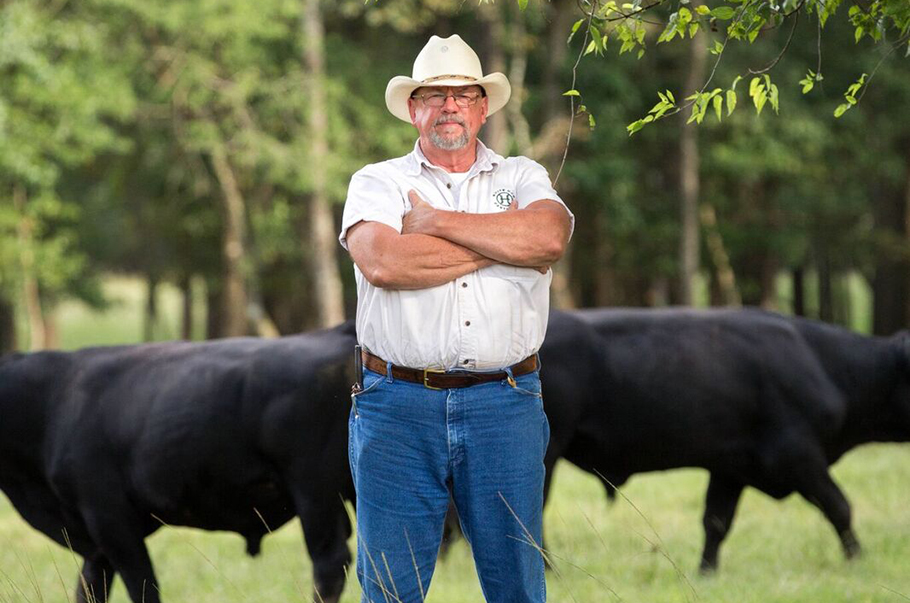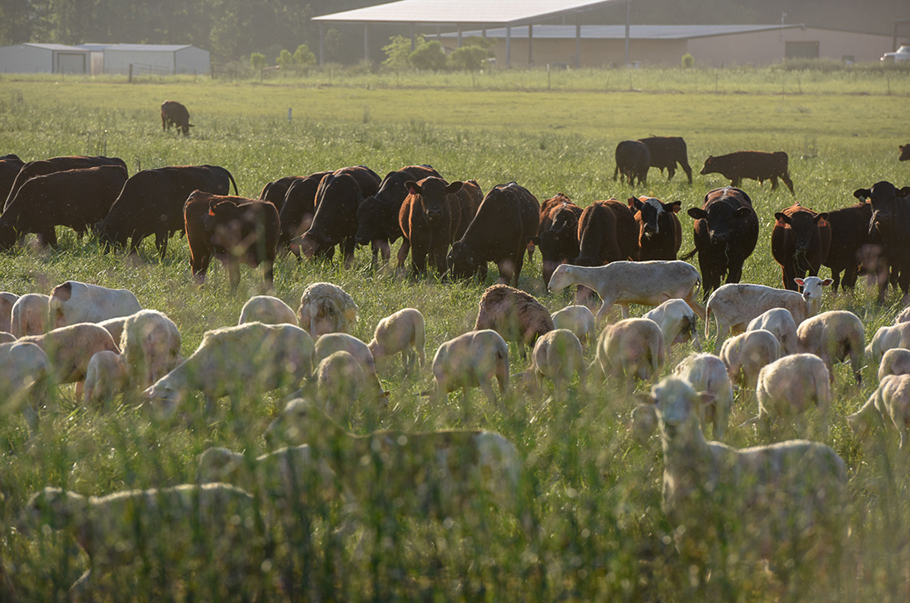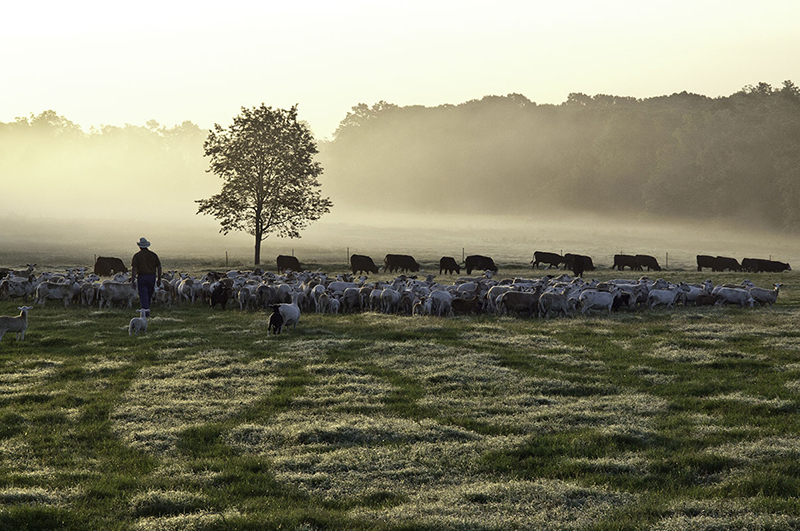
Research with Exciting Implications for Regenerative Agriculture and Climate Change
by Sheryl Karas M.A., CRARS staff

Meet Will Harris, owner of White Oak Pastures in Bluffton, Georgia and one of our mentor-farmers(opens in new window) at CRARS. Over the past 25 years it has been his pride and joy to have transformed about 3000 acres of degraded cropland into a fully regenerative and 100% certified organic ranch that not only supplies meat, eggs, and vegetables for the local community and surrounding region. It also has provided jobs for 165 people, including the 16 new workers brought on during this past pandemic year, in one of the poorest counties in the state of Georgia. In particular, this has created dramatic improvements for Bluffton, a once-impoverished town of just 100 people, as all processing of the meat is now done locally and humanely right at the ranch. And recently, due to a study(opens in new window) published in “Frontiers in Sustainable Food Systems,” Harris received the happy news that his work has paid off in terms of making the world healthier in the face of climate change as well!
The research showed dramatic increases in soil carbon sequestration, resulting in a carbon footprint 66% lower than conventional operations. According to Quantis, who did the Life Cycle Assessment used in the recently published study, White Oak Pastures is storing more carbon in its soil than its cows emit(opens in new window) during their lifetime. White Oak Pastures offsets at least 100% of their grassfed beef carbon emissions and as much as 85% of the farm's total carbon emissions.
The White Oak Pastures approach is unusual among meat producers in the United States at the current time. The norm is to raise a single species (for instance, cattle), grazing the same land year after year, who are then “finished” by being fed grain in tightly packed feedlots until the animals are shipped away from the local community to be slaughtered, processed in centralized meat packaging plants, and distributed across the globe. Ranchers adopted this approach for efficiency and lower land use, and the practice has only become more entrenched as population growth and improved prosperity has increased the demand for meat worldwide.
By contrast, Will Harris employs a practice that on the surface, at least, is more reminiscent of what ranchers and farmers were doing generations ago. Like Old MacDonald of children’s song fame, he raises crops and multiple species of animals on the same property, something that is the norm outside of the United States. Diversified farms and ranches actually supply 60% of the world’s meat and 75% of the world’s dairy. What’s significantly different, however, are the specifically regenerative processes White Oak Pastures has been using in the process of step by step transitioning away from the use of heavy tillage, chemicals, and other more conventional practices.
How White Oak Pastures Regenerates Degraded Cropland

Will Harris starts by buying land that has become degraded by growing corn, peanuts, wheat, and soybeans using conventional methods for at least a decade. Then he starts a three-year plan to transition away from the use of chemical fertilizers and herbicides. This can be challenging as different properties have different soil and other characteristics and start at varying levels of fertility. But generally speaking, during the first 1-3 years, his cattle are fed hay during the winter and are grazed along with poultry at low stock densities. The cattle incorporate their manure and the organic matter from unconsumed hay into the soil with their hooves while the birds eat grubs and insects and provide different nutrients from their urine and manure. Compost is also applied and the land is seeded.
After three years, a holistic managed grazing plan is used. The stock density is increased and the animals are rotated frequently from paddock to paddock before the grass is eaten too low to the ground. The land is allowed to rest and recover between periods of grazing. From that point on, no more external inputs of hay, seeds or compost are used or needed. Cattle, sheep and goats, a variety of poultry species (laying hens, guinea fowl, turkeys, ducks, and geese), pigs, and rabbits, are moved together in a variety of herd combinations across the farm. This is called Multi-Species Pasture Rotation (MSPR) and is intended to mimic and make use of the symbiotic effects of multiple species living in close proximity, moving across the landscape, and interacting as they do in nature. The study published in “Frontiers in Sustainable Food Systems” was specifically interested in the ecosystem impact and production effects of this type of diversified farming approach.
Other regenerative practices White Oak Pastures employs include adding a variety of plants and nut trees to the farm landscape to increase native plant diversity and provide a comfortable place for their hogs to root (a practice known as silvopasture)(opens in new window). They plant perennial fruiting shrubs and trees near the vegetable garden to help grow and maintain microbial networks in the soil, and use herbs and specific vegetables as companion plantings near other crops to improve soil fertility and sometimes to deter insects. Some crops are chosen because they have deeper roots that can help bring nutrients up from lower levels of the soil, and legumes are used to help make nitrogen available to surrounding plants. To help suppress weeds, they use cover crops such as crimson clover, winter wheat, sudan grass, and white Dutch clover. When it is time to harvest, they cut the plants at the base and leave the roots in the ground to avoid disturbing the soil biology as much as possible.
The Research and its Findings
Because most of the research that studies livestock production in the United States leaves out diversified farming practices, this project was designed to compare the land-use trade-offs of the White Oak Pastures system with the typical findings collected from conventional production systems for each of the species raised on this ranch. The key tool used in this study was whole-farm life cycle assessment which is an accounting approach used to analyze the environmental impacts and resources used throughout a farm product's life including every step of raising the animal or crop through to product use and disposal. In this case, the researchers wanted a comparison of production outputs, greenhouse gas (GHG) emissions, land footprints, and soil health outcomes including soil carbon sequestration.
As part of the assessment they did a 20-year chronosequence of soil carbon and other soil health indicators. A chronosequence involves sampling soils representing different landscape ages. Because White Oak Pastures has been in the process of buying cropland each year and regenerating it for 25 years, researchers were in the unique position of being able to take samples representing each stage of the process starting with degraded cropland and proceeding to fully certified organic regenerated land with production maintained through MSPR alone.
Findings
Researchers found that the productivity of White Oak Pastures, when all animal products are combined, was substantially higher than other grass-finished operations producing beef alone. However, the production of beef alone was somewhat less.
Substantial increases were found across a suite of soil health indicators over the 20-year chronosequence:
- Wet aggregate stability (the ability for soil to resist falling apart and being washed away by rain) increased from 0 to 53% with a 5-fold increase between years 3 and 20.
- Microbial respiration doubled.
- POXC (permanganate oxidizable carbon, a measurement of the amount of active soil carbon stored in the soil) increased 10 times.
- ACE protein, which estimates the amount of mineralizable organic nitrogen, increased 5 times.
- Measurements of soil organic carbon (SOC stock) also increased 5 times.
The issue of GHG net emissions is complex. On the one hand, the overall carbon footprint for White Oak Pastures was 44% greater than conventional production methods for all the varieties of livestock combined. This is mostly due to the fact that grass-finished cattle emit more methane than those finished on grain because of differences in digestibility. However, methane is a short-lived pollutant compared to the fossil fuel emissions related to fertilizer production and energy use in a feedlot system. And, when soil carbon sequestration is integrated into the calculations as a GHG sink, it reduced net emissions 5-fold to a level that was significantly less than conventional production. When looking at cattle alone, the net sink would actually result in negative numbers. In other words, the carbon sequestration value of the beef produced at White Oak Pastures offsets 100% of the emissions created through raising the animals and then some.
Another factor to be considered is that the cattle at White Oak Pastures reach a harvestable weight at an earlier age than in conventional production, 20-22 months as compared to 30. That means they contribute 43% fewer GHGs over their lifetime. When all factors are combined, the GHG footprint at this ranch was 66% lower than comparable conventional production.
The soil health, GHG emission, and carbon sequestration benefits are unquestionable but, unfortunately, it comes with a price tag in terms of land use. Researchers found that White Oak Pastures uses 2.5 times the land for the amount of meat produced than a typical conventional operation. This would not be entirely unexpected as the conventional systems group one type of animal in the same confined space year after year while MSPR systems move animals across a landscape allowing time for each section of the property to rest and regenerate.

What Does This Mean (Potentially) for the More Widespread Adoption of MSPR?
The value of land space used versus the ecological health of that land is a matter of priorities, and the authors of the study concluded that these complexities should be considered in future global debates about agricultural practices. However, it should also be noted that the scope of this study did not include an assessment of animal health, the nutritional quality of the meat and eggs produced, or the health and well-being of the people who work in this production system, the impact on the local community, and on the consumers who receive the products.
The authors of the study did, however, discuss that land use trade-offs might be offset by the ability to implement these techniques on marginal lands, similar to the degraded cropland used by White Oak Pastures. That would free up more productive land for higher value, nutrient dense crops. They also wanted to emphasize the importance of the enhanced ecological health of the land used in an MSPR system in terms of farm resiliency and ability to adapt to extreme weather, nutrient cycling, water retention, and climate change mitigation.
More research would be needed to evaluate the economic and collateral impacts of all of these factors in regards to future decision-making. But the authors of the study believe their results indicate the value of MSPR was so great as to warrant incentivizing use of this approach to raising meat, while continuing to investigate approaches to reduce the land necessary to do it.
